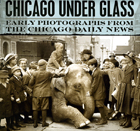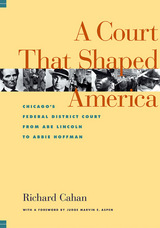2 books about Cahan, Richard

Chicago under Glass
Early Photographs from the Chicago Daily News
Mark Jacob and Richard Cahan in association with the Chicago History Museum
University of Chicago Press, 2007
When the Chicago Daily News closed its doors in March 1978 after over a century of publication, the city mourned the loss of an American original. The Daily News boasted the inventive, aggressive writing of such luminaries as Carl Sandburg and Ben Hecht. It was also one of the first newspapers in the country to feature black-and-white photography. In 1900, staffers from the paper’s art department began lugging bulky cameras, heavy glass plates, and explosive flash powder throughout the city. A labor strike, a boxing match, or a crime scene—it was all in a day’s work for the Daily News photographer.
These cameramen helped sell papers, but, as Mark Jacob and Richard Cahan reveal, they also made art. Chicago under Glass: Early Photographs from the Chicago Daily News is the first collection of images from the photo staff’s early years, 1901 to 1930. Jacob and Cahan, seasoned journalists themselves, have selected more than 250 images—many of which have never before been published—from the nearly 57,000 glass negatives housed at the Chicago History Museum. They include rare photographs of a young Buster Keaton with his wife and child, waiting to board a train and the notorious Al Capone outside a courtroom, smoking a cigar and consulting with his lawyer. Each thematic section begins with a fascinating introduction by the authors, and each image is accompanied by insightful historical commentary.
These fragile glass records are a remarkable piece of American history. Together, they capture a time of massive change and stark contrasts, the defining years in a place Nelson Algren called “Hustlertown.” From candid shots of the Eastland steamer disaster to the glittering electric lights of the White City amusement park and the grim aftermath of the Saint Valentine’s Day Massacre, the history these images reveal is not simply the story of Chicago, but the history of the modern American city.
[more]

A Court That Shaped America
Chicago's Federal District Court from Abe Lincoln to Abbie Hoffman
Richard Cahan
Northwestern University Press, 2002
Big and small dramas play out every day in the United States District Court for the Northern District of Illinois. Headquartered in Chicago, the court has played a pivotal role in U.S. history. This is where Abraham Lincoln, as a young lawyer, changed the direction of westward expansion when he argued that trains-not steamships-were America's future. This is where Al Capone met his fall, at a trial that finished him as Public Enemy Number One. And this is where Abbie Hoffman, the nation's first Yippie, butted heads with Judge Julius J. Hoffman and the Establishment at the trial known as the Conspiracy Eight.
A Court That Shaped America traces the flesh-and-blood courtroom scenes from the district's first cases in the early nineteenth century through the turn of the millennium. Historical figures--including Mormon leader Joseph Smith, inventor Thomas Edison, and author Mark Twain--as well as contemporary superstars like Michael Jackson and Oprah Winfrey have all had their day in the Northern Illinois court. Some were victorious; some came out scathed. This book examines these great trials and the people behind them to offer a unique look at Chicago and U.S. history.
A Court That Shaped America traces the flesh-and-blood courtroom scenes from the district's first cases in the early nineteenth century through the turn of the millennium. Historical figures--including Mormon leader Joseph Smith, inventor Thomas Edison, and author Mark Twain--as well as contemporary superstars like Michael Jackson and Oprah Winfrey have all had their day in the Northern Illinois court. Some were victorious; some came out scathed. This book examines these great trials and the people behind them to offer a unique look at Chicago and U.S. history.
[more]
READERS
Browse our collection.
PUBLISHERS
See BiblioVault's publisher services.
STUDENT SERVICES
Files for college accessibility offices.
UChicago Accessibility Resources
home | accessibility | search | about | contact us
BiblioVault ® 2001 - 2024
The University of Chicago Press









